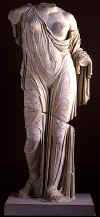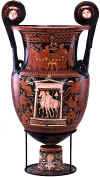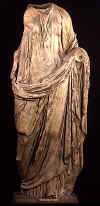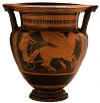A History of Ancient Greece
The Glory That Was Greece
Date: 1992
Greek Art

Greek, Hellenistic period; 1st century B.C. copy of 4th century B.C. original; Marble; 68.6 cm (27 in.); Founders Society Purchase, General Membership Fund; 24.4
The torso is an impressive example of the respect and enthusiasm the ancient Greeks felt for renowned works of art by famous Greek artists of an earlier time. The DIA Aphrodite is an adaptation based on a statue by the 4th century B.C. artist Praxiteles. This revered sculpture of the goddess Aphrodite was created for her temple at Knidos, on the Aegean coast of modern Turkey.

Venus Genetrix
1st century A.D.; Roman copy of late 5th century B.C. original; Marble; height 153.7 cm (60 1/2 in.); Gift of Mr. and Mrs. Henry Ford II; 74.53
Toward the end of the 5th century B. C. a famous Greek statue of Aphrodite, the goddess of love, was created, probably to decorate a temple in Athens. It was such a popular image that it was later copied many times. The type became known throughout the Greco-Roman world and was associated with the Roman goddess Venus.
In more complete examples, Aphrodite is shown holding the apple awarded her in the contest among goddesses where she was judged the most beautiful. Female nudity was not sanctioned in art until later in Greek history but artists discovered a way to reveal aspects of feminine grace. Aphrodite's garments cling to her body, outline and emphasize the contours, creating the illusion of female beauty at its most sensuous.

Volute Krater
320-310 B.C.; The Baltimore Painter; Greek, South Italian, Apulian; Ceramic; height 1.2 m (47 1/2 in.); Founders Society Purchase with funds from various contributors; 1983.25
Intended to serve as a funerary offering, this volute Krater, set in its own stand, was created in a Greek colony in southeastern Italy. On the obverse (front) of the krater, an image of the deceased with his horse is shown as part of a funerary monument. Above is a scene of banqueting. The colonial artist, in a style characteristically his own, has densely packed the reverse surface of the vessel with a complex assembly of the major deities of the Greek pantheon. Zeus, enthroned in the center, is flanked by gods and goddesses identified by the attributes they hold. Below Dionysus and Ariadne ride in a chariot drawn by two panthers. Greeks and Amazons battle above.

Head of Aristaeus
150-100 B.C.; Greek, Hellenistic period; Marble; height 52.1 cm (20 1/8 in.); Founders Society Purchase, Membership and Donations Fund; 41.9
Aristaeus was the divine son of the god Apollo and the nymph Cyrene. He was known in the ancient world as the founder and patron deity of the city of Cyrene in Libya, a Greek colony in North Africa. This head, from a colossal statue, portrays the god with a rather bland face surrounded by tousled assymetrical curls, which are given dramatic life by being carved in high relief. On Aristaeus's head is a mural crown -- a round flat-topped headdress with four vertical raised strips, perhaps intended to represent the defensive towers of the city walls. The enormous statue could have stood in a temple in Cyrene dedicated to Aristaeus.

Draped Woman
2nd-1st century B.C.; Greek, Late Hellenistic period; Marble; height 1.5 m (61 in.); City of Detroit Purchase; 24.113
The beautifully draped statue of a mature woman may be a representation of Calliope, the muse of epic poetry. A flat surface on the folds of the cloak against the left arm of the figure may have held a tablet, an attribute of Calliope. She might have been fashioned as a funerary monument, representing a deceased matron as Calliope, or as part of a public sculpture with all nine muses portrayed. Her stance produces a gentle curve to her body. Since the back of the statue is unfinished, it was presumably set against a wall or in a niche. The work of art appears to be a late Hellenistic copy of an early Hellenistic creation, elegant even though incomplete.

Column Krater
ca. 470-65 B.C.; The Leningrad Painter; Greek, Attic red-figure ware; Ceramic; height 40 cm (15 5/8 in.); City of Detroit; 24.120
This vessel, with handles reminiscent of columns, was designed as a container in which to mix wine and water for serving at social gatherings. On the most important side of the krater, Helios, the sun god, wearing a rayed sun disk on his head, is shown standing in his chariot drawn by two winged horses. He represents the sun in its daily journey across the sky; the ocean waves and a leaping dolphin lie below.

Corinthian Columns

